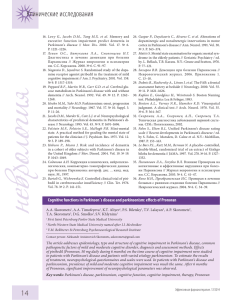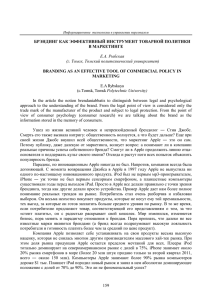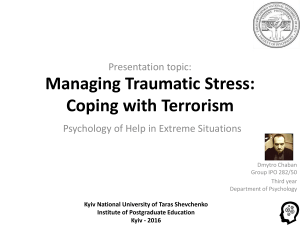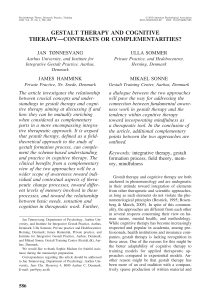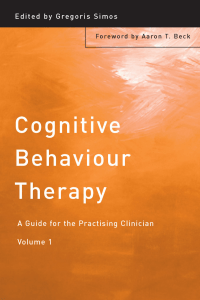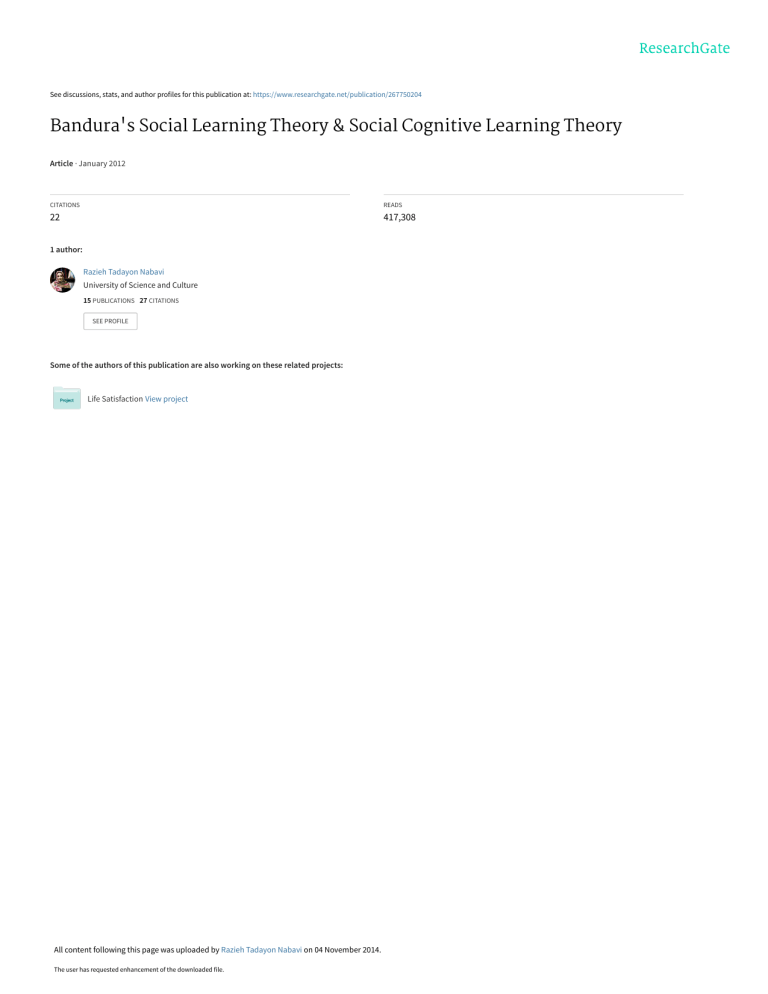
See discussions, stats, and author profiles for this publication at: https://www.researchgate.net/publication/267750204 Bandura's Social Learning Theory & Social Cognitive Learning Theory Article · January 2012 CITATIONS READS 22 417,308 1 author: Razieh Tadayon Nabavi University of Science and Culture 15 PUBLICATIONS 27 CITATIONS SEE PROFILE Some of the authors of this publication are also working on these related projects: Life Satisfaction View project All content following this page was uploaded by Razieh Tadayon Nabavi on 04 November 2014. The user has requested enhancement of the downloaded file. Theories of Developmental Psychology Title: Bandura’s Social Learning Theory & Social Cognitive Learning Theory Razieh Tadayon Nabavi 2011-2012 Table of content Father of the Cognitive Theory.................................................................................. 3 Introduction ................................................................................................................. 3 Social Learning Theory (SLT) ................................................................................... 5 General principles of SLT ...................................................................................................... 6 Behaviors learned through modeling ..................................................................................... 7 SLT Concepts......................................................................................................................... 8 Observational Learning ...................................................................................................... 8 Intrinsic Reinforcement...................................................................................................... 9 Modeling Process ............................................................................................................... 9 SLT perspectives .................................................................................................................. 10 Social Cognitive Learning Theory (SCLT)............................................................. 11 Basic Assumptions of SCLT ................................................................................................ 11 Cognitive Features on SCLT................................................................................................ 13 Phenomena of SCLT ............................................................................................................ 13 Internal principle of SCLT ................................................................................................... 14 Self-efficacy and SCLT ................................................................................................... 15 Self-regulation and SCLT ................................................................................................ 17 The Linking between SLT and SCLT ..................................................................... 18 Strengths and Weaknesses of SLT .......................................................................... 18 Strengths of SCLT .................................................................................................... 19 Limitations of SCLT ................................................................................................. 19 Conclusion.................................................................................................................. 20 References .................................................................................................................. 22 2 Father of the Cognitive Theory Albert Bandura is known as the father of cognitive theory. He was born December 4, 1925 in a small town in northern Alberta, Canada, located approximately 50 miles from Edmonton. Bandura’s early education consisted of one small school with only two teachers. (Stokes, 1986). Albert Bandura soon became fascinated by psychology after enrolling at the University of British Columbia. He had started out at biological sciences major, his interest in psychology formed quite by accident. He was working nights and commuting to school with a group of students who arrived much earlier than his other courses started. ( Pajares, 2004). In 1949 he graduated from the University of British Columbia with a degree in Psychology. He received his Ph.D. in Clinical Psychology from the University of Iowa in 1952. After he finished his PhD because of his famous studies and searches Bandura was elected as the president of the American Psychological Association in 1974. He was also elected as the outstanding lifetime contribution to Psychology, American Psychological Association in 2004. Among all scholars Bandura was known as the father of the Cognitive Theory. (Bandura, 2006a). Introduction Based on previous studies, learning is defined as “A persisting change in human performance or performance potential as a result of the learner’s interaction with the environment” (Driscoll, 1994, pp. 8-9). Learning is also elucidated by Weinstein & 3 Mayer (1986) as “The relatively permanent change in a person’s knowledge or behavior due to experience” (p. 1040). On this point, Shuell (1986) clarified learning as “An enduring change in behavior, or in the capacity to behave in a given fashion, which results from practice or other forms of experience” ( p. 412). Learning theories see the environment as the major force in development. (Hoffman, 1993). Scholars categorized learning theories as Behaviorism, Social Learning Theory (SLT) and Social Cognitive Learning Theory (SCLT). In the context of study, Albert Bandura is arguably the most eminent living psychologist. His Social Cognitive theory has influenced many areas of inquiry: education, health sciences, social policy and psychotherapy among others. (See figure 1) SLT via observation, imitation, and modeling SCLT via observation understanding, predicting and changing human behavior. SLT & SCLT are based on Observation Figure 1 Process of SLT and SCLT based on observation 4 Social Learning Theory (SLT) Social learning theory is increasingly cited as an essential component of sustainable natural resource management and the promotion of desirable behavioural change. (Muro & Jeffrey 2008). This theory is based on the idea that we learn from our interactions with others in a social context. Separately, by observing the behaviors of others, people develop similar behaviors. After observing the behavior of others, people assimilate and imitate that behavior, especially if their observational experiences are positive ones or include rewards related to the observed behavior. According to Bandura, imitation involves the actual reproduction of observed motor activities. (Bandura 1977). SLT has become perhaps the most influential theory of learning and development. It is rooted in many of the basic concepts of traditional learning theory. This theory has often been called a bridge between behaviorist learning theories and cognitive learning theories because it encompasses attention, memory, and motivation. (Muro & Jeffrey 2008). However, on this regards, Bandura believes that direct reinforcement could not account for all types of learning. For that reason, in his theory he added a social element, arguing that people can learn new information and behaviors by watching other people. According to the elements of this theory there are three general principles for learning from each other. 5 General principles of SLT The principles of social learning are assumed to operate in the same way throughout life. Observational learning may take place at any age. Insofar as exposure to new influential, powerful models who control resources may occur at life stage, new learning through the modeling process is always possible. (Newman B.M. & P.R, 2007). SLT posits that people learn from one another, via: Observation; Imitation; and Modeling Based on these general principles, learning can occur without a change in behavior. In other words, behaviorists say that learning has to be represented by a permanent change in behavior; while in contrast social learning theorists say that because people can learn through observation alone, their learning may not necessarily be shown in their performance. (Bandura, 1965). Learning may or may not result in a behavior change. (Bandura, 2006b). Bandura demonstrated that cognition plays a role in learning and Over the last 30 years social learning theory has become increasingly cognitive in its interpretation of human learning; these points supported by (Newman B.M. & P.R, 2007). 6 Behaviors learned through modeling The people who are being observed are called models and the process of learning is called modeling. This point supported by (Newman B.M. & P.R, 2007). Bandura’s stated second and third stages of social learning, imitation and behavior modeling, will occur if a person observes positive, desired outcomes in the first stage. If, for example, an instructor attends and observes a course in-world and is entertained, informed, and approves of the way students act, they are more likely to want to teach a course in-world themselves. They can then use the behavior they experienced to imitate and model other instructors’ teaching styles in-world (Bandura, 1986) Previous studies confirmed that at least partly of many behaviors can be learned through modeling. Some examples that can be cited on this regards are, students can watch parents read, students can watch the demonstrations of mathematics problems, or seen someone acting bravely and a fearful situation (Bandura, 2006a). Based on this point, aggression can also be learned through models. Much research indicates that children become more aggressive when they observed aggressive or violent models. From this view, moral thinking and moral behavior are influenced by observation and modeling. In consequence, learing includes moral judgments regarding right and wrong which can in part, develop through modeling. 7 SLT Concepts Based on the literature, there are three concepts in SLT. Firstly, people can learn through observation which is known as observational learning. Secondly, mental states are important factor for learning it is also named as intrinsic reinforcement. Finally, it refers to this point that learning does not necessarily lead to a change in behavior and it follows by modeling process. Observational Learning In 1961 Bandura conducted his famous experiment known as the Bobo doll experiment, to study patterns of behavior, at least in part, by social learning theory, and that similar behaviors were learned by individuals shaping their own behavior after the actions of models. Bandura's results from the Bobo Doll Experiment changed the course of modern psychology, and were widely credited for helping shift the focus in academic psychology from pure behaviorism to cognitive. The experiment is among the most lauded and celebrated of psychological experiments. (Newman B.M. & P.R, 2007). The study was significant because it departed from behaviorism’s insistence that all behavior is directed by reinforcement or rewards. The children received no encouragement or incentives to beat up the doll; they were simply imitating the behavior they had observed. Bandura termed this phenomena observational learning and characterized the elements of effective observational learning as attention, retention, reciprocation and motivation. He demonstrated that children learn and imitate behaviors which they have observed in other people. On this process, he identified three basic models of observational learning: 8 A live model, which involves an actual individual demonstrating or acting out a behavior. A verbal instructional model, which involves descriptions and explanations of a behavior. A symbolic model, which involves real or fictional characters displaying behaviors in books, films, television programs, or online media. Intrinsic Reinforcement One of the other formats of learning is described as a form of internal reward, such as pride, satisfaction, and a sense of accomplishment. Based on some researchers such as Muro and Jeffrey (2008) which supported Bandura’s SLT concepts this kind of learning also emphasis on internal thoughts and cognitions and it can help connect learning theories to cognitive developmental theories. On this regards, Bandura (1986), criticized this process and believed that external, environmental reinforcement is not the only factor to influence learning and behavior. Modeling Process Bandura mentions four necessary conditions which are needed in modeling process. By considering these steps, an individual can successfully make the behavior model of someone else. These conditions are shown in figure 2 briefly. 9 1. Attention The person must first pay attention to the model. The more striking or different something is the more likely it is to gain our attention. Likewise, if we regard something as prestigious, attractive or like ourselves, we will take more notice. (eg. Color) 2. Retention The observer must be able to remember the behavior that has been observed. One way of increasing this is using the technique of rehearsal. Modeling Process 4. Motivation The final necessary ingredient for modeling to occur is motivation, learners must want to demonstrate what they have learned. Remember that since these four conditions vary among individuals, different people will reproduce the same behavior differently. Reinforcement and punishment play an important role in motivation. 12 3. Reproduction The third condition is the ability to replicate the behavior that the model has just demonstrated. This means that the observer has to be able to replicate the action, which could be a problem with a learner who is not ready developmentally to replicate the action. 12/17/2011 Figure 2 conditions which are needed in modeling process SLT perspectives From the SLT view, the perspectives of reinforcement and punishment (R&P) can be categorized as follow: Indirect effects on learning and they are not the sole or main cause; Influence the extent to which an individual exhibits a behavior that has been learned; 10 Influences expectation of reinforcement on cognitive processes that promote learning; Attention pays a critical role in learning and; Attention is influenced by the expectation of reinforcement. Social Cognitive Learning Theory (SCLT) Based on the above discussion SCLT is a learning theory which has come out on the ideas that people learn by watching what others do, and that human thought processes are central to understanding personality. By the mid-1980s, Bandura's research had taken a more holistic bent, and his analyses tended towards giving a more comprehensive overview of human cognition in the context of social learning. The theory he expanded from social learning theory soon became known as social cognitive theory. (Bandura, 1999). This theory provides a framework for understanding, predicting and changing human behavior. (Green & Peil, 2009). Moreover, SCLT places a heavy focus on cognitive concepts. It is also focused on how children and adults operate cognitively on their social experiences and how these cognitions then influence behavior and development. Basic Assumptions of SCLT Bandura (2006a) often objects to being associated with American behaviorists primarily because he views his theory as “cognitive” and not “behaviorist.” That objection 11 notwithstanding, his emphasis on the social origins of cognitive processes is why his work falls within the exogenous paradigm of developmental theories. In short, he argues that individuals learn both behaviors and cognitive strategies by observing the behavior of others, and these acquisitions can be learned without being directly reinforced. (Green & Peil, 2009). Mccormick and Martinko (2004), based on their studies introduce some basic assumptions of Bandura’s SCLT. They claimed that: People can learn by observing others; Learning is an internal process that may or may not result in a behavior change; Learning can occur without a change in behavior (Observation without imitation); Regarding to behavior, some other researchers such as Betz, (2007), supported Bandura’s basic assumptions of SCLT and pointed that: Behavior is directed toward particular goals; Behavior eventually becomes self-regulated; Cognition plays a role in learning; and Finally, some studies supported that reinforcement and punishment have indirect rather than direct effects on learning and behavior. (Green & Peil, 2009). 12 Cognitive Features on SCLT Researchers according to their studies presented the following five cognitive features that can influence behavior in SCLT: Expectations of future consequences & responses based on current situation/s; Vicarious experiences of others’ consequences; Expectations about future consequences affect how we cognitively process of new information; Expectations affect decisions about how to behavior; and Nonoccurrence of expected consequences have effects Phenomena of SCLT Social cognitive theory attempts to explain socialization broadly, including processes whereby individuals acquire their society’s norms of thought and action. Within this broad agenda, Bandura attempts to explain four types of learning effects. (Green & Peil, 2009). The four features for phenomena on SCLT are as follow: 1. Observational Learning Effect Acquiring new behavior from model 2. Response Facilitation Effect According to the literature increased frequency of learned behavior after model is reinforced for same behavior. 3. Response Inhibition Effect; 13 Decreased frequency of learned behavior after observing punished model. 4. Response disinhibition Effect Return of inhibited response after observing model behave that adverse consequences. Internal principle of SCLT People are only partial products of their environments. Just as important is the fact that we create beneficial environments and then proceed to exercise control over them. By selecting environments carefully, we can influence what we become. Our choices are influenced by our beliefs as well as our capabilities (Bandura, 1997). Bandura proposes only a single internal principle comprised of three interacting elements. This principle is termed triadic reciprocality. Some scholars in the area of SCLT like Betz, 2007, and Green & Peil, 2009 supported Bandura view of triadic reciprocality and define human behavior as a triadic, dynamic, and reciprocal interaction of personal factors, behavior, and the environment. On a closer observation, these three fundamentals work in a reciprocal nature. Figure 3 shows these principles more clearly. 14 Figure 3 Internal principle of SCLT Self-efficacy and SCLT self-efficacy in the Bandura theory introduced context of an explanatory model of human behavior, in which self-efficacy causally influences expected outcomes of behavior, but not vice versa (Bandura, 1986c, 1995, 1998, 2004, 2006b). Self-efficacy beliefs exert their diverse effects through cognitive, motivational, emotional, and decisional processes. Efficacy beliefs affect whether individuals think optimistically or pessimistically, in self-enhancing or self-debilitating ways. They play a central role in the self-regulation of motivation through goal challenges and outcome expectations. (Mark & Campbell, 2011). On this regard self efficacy lies at the center of SCLT and shows that beliefs about one’s ability or capacity to execute a behavior 15 successfully. Moreover, it clarifies that people tend to engage in activities based on their sense of competence &/or past success. One of the primary features of Bandura’s model is the specification of four sources of efficacy information, or learning experiences, leading to the development of selfefficacy expectations. It remains important as it is part of Bandura’s social cognitive theory and is an integral part of SCCT. Betz (2007). In other words, some researchers like Betz (2007) and Mccormick, & Martinko, (2004), supported self-efficacy based on bandura’s idea and suggested that self efficacy can affect on behavior & cognition in the following ways: Activity choice Goal setting Effort & persistence Learning & achievement They concluded that people with high efficacy are more likely to view difficult tasks as something to be mastered rather than something to be avoided while the people with weak efficacy more likely to avoid challenging tasks and finally they focus on personal failings and negative outcomes. (Mark & Campbell, 2011). 16 Self-regulation and SCLT Central to SCT is the idea that people are capable of self-regulation their thoughts, emotions, motivation, and actions. Self-regulation refers to the process in which people control and direct their actions. It conceives of the individual as being goal directed and actively involved in developing functional patterns of thinking and behaving in response to environmental conditions in order to attain personal goals. Effective self-regulation is a cyclical process in which performers actively monitor the performance environment, develop functional task strategies, skillfully implements those plans, and monitor the results. ( Locke & Latham, 1990). Self-regulation has come to be more emphasized in SLT however in SCLT selfregulation is considered when an individual has his own ideas about what is appropriate or inappropriate behavior and chooses actions accordingly (Williams 2010). Bandura (1978) in his theory presented promoting self-regulation as an important technique. He believes it is usually done by teaching the individual to reward himself after doing the needed behavior. Figure 4 shows the process and stages of self regulation. 17 Figure 4 the process and stages of self regulation The Linking between SLT and SCLT In 1986, Bandura based on his studies and findings decided to rename his SLT to Social Cognitive Learning Theory (SCLT). In other words, the Social Cognitive learning Theory (SCLT) stemmed for a better description from the SLT which had been advocating since1960's. Strengths and Weaknesses of SLT Based on previous studies, strengths and weakness of SLT can be broken down into two categories. The first one is positive reinforcement and it means the action mimicked by the observer is a positive one, therefore the action may be reward able or commended by 18 others. The second one is punishment and it uses when the action mimicked by the observer is negative and may offend or harm others, thereby leading to a form of punishment. Basically, according to the literature the main strength & weakness of Social/Observational learning depends on the model. According to this point, if the model is producing a behavior that is appropriate, responsible and positive overall, the observer will mimic that positive good behavior. So, as future educators, we need to be constantly aware of how we present ourselves and of our actions. Finally, it can be said if we believe Bandura's theory is correct, that means the things we do are under constant watch by others. Strengths of SCLT Based on the literature, some strengths for SCLT can be listed as follow: Accumulated an impressive research record Concerned with important human social behaviors An evolving theory that is open to change Focused on important theoretical issues, e.g., role of reward in learning, the stability of behavior Reasonable view of people and concern with the social implications of the theory Limitations of SCLT Some researchers based on their findings reported some limitations for SCLT however some believes the theory's comprehensiveness and complexity make it difficult to 19 operation allies; many applications of the SCLT focus on one or two constructs, such as self-efficacy, while ignoring the others. 1. Not a fully systematized, unified theory; loosely organized 2. Controversial issues: Is reinforcement necessary for both learning and performance? Is self-efficacy just another outcome expectancy? Why are some self-efficacy expectancies stable and others susceptible to rapid change? If self-efficacy expectancies are situation specific, how do they relate to broader personality? Why are some self-efficacy beliefs apparently unrelated to behavior, e.g., stop smoking? Relies on self-reports excessively 3. Neglected areas: Maturation and changes over the lifespan ignored Minimal attention to motivation, conflict, and emotion 4. Findings are preliminary Are cognitive processes the basic concepts of personality? Are modeling and guided participation able to handle many psychological problems? Conclusion The SLT and SCLT theories have often been called a bridge between behaviorist learning theories and cognitive learning theories because they encompass attention, memory, and motivation. It is also placed a heavy focus on cognitive concepts. Moreover, Albert Bandura is arguably the most eminent living psychologist. His Social Cognitive theory has influenced many areas of inquiry: education, health sciences, social policy and psychotherapy among others. On a closer observation, however, social cognitive theory has its roots in American behaviorism, but Bandura extends radical 20 behaviorism to include cognitive factors in his account of social learning. Finally, as Green & Peil, in 2009, reported he has tried to use cognitive theory to solve a number of global problems such as environmental conservation, poverty, soaring population growth and etc. 21 References Bandura, A. (1965). Influence of models' reinforcement contingencies on the acquisition of imitative responses. Journal of personality and social psychology, 1(6), 589. Bandura, A. (1977). Self-efficacy: toward a unifying theory of behavioral change. Psychological review, 84(2), 191. Bandura, A. (1978). Reflections on self-efficacy. Advances in behaviour research and therapy, 1(4), 237-269. Bandura, A. (1986). Social foundations of thought and action. Upper Saddle River, NJ: Prentice Hall. Bandura, A. (1995). ON rectifying conceptual ecumenism. In J. E. Maddux (Ed), Selfefficacy, adaption, and adjustment: Theory, research, and application. New York. (4), 347-375 Bandura, A. (1997). Self-efficacy: The exercise of control. New York: W. H. Freeman. Bandura, A. (1998). Health promotion from the perspective of social cognitive theory. Psychology and Health, 13(4), 623-649. Bandura, A. (1999). A social cognitive theory of personality. In L. Pervin & O. John Hnadbook of personality. New York, Guildford Publications: 154-196. Psychological review 106(4), 676. Bandura, A. (2004). Health promotion by social cognitive means. Health Education & Behavior, 31(2), 143. Bandura, A. (2006b). Toward a psychology of human agency. Perspectives on Psychological Science, 1(2), 164. Bandura, A.(2006a). Autobiography. MG Lindzey & WM Runyan (Eds.), A history of psychology in autobiography (Vol. IX). Washington, DC: American Psychological Association. Betz, N. E. (2007). Career self-efficacy: Exemplary recent research and emerging directions. Journal of Career Assessment, 15(4), 403-422. Driscoll, M. P. (1994). Psychology of Learning for Instruction: Allyn & Bacon, A Division of Paramount Publishing, Inc., 160 Gould Street, Needham Heights, MA 02194. 22 Green, M., & Piel, J. A. (2009). Theories of human development: A comparative approach (second ed.): Prentice-Hall, Inc. Hoffman, L. W. (1993). Hoffman Devlopmental Psychology Today: McGraw-Hill Companies, The. Locke, E. A., & Latham, G. P. (1990). Work motivation and satisfaction: Light at the end of the tunnel. Psychological Science, 1, 240-246. Mark, M. M., Donaldson, S. I., & Campbell, B. (2011). Social psychology and evaluation: The Guilford Press. Mccormick, M. J., & Martinko, M. J. (2004). Identifying leader social cognitions: Integrating the causal reasoning perspective into social cognitive theory. Journal of Leadership & Organizational Studies, 10(4), 2-11. Muro, M., & Jeffrey, P. (2008). A critical review of the theory and application of social learning in participatory natural resource management processes. Journal of environmental planning and management, 51(3), 325-344. Newman, B. M., & Newman, P. R. (2007). Theories of human development: Lawrence Erlbaum. Pajares, F. (2004). Albert Bandura: biographical sketch. Retrieved April, 10, 2006. Shuell, T. J. (1986). Cognitive conceptions of learning. Review of educational research, 56(4), 411. Stokes, D. (1986). Chance can play key role in life psychologist says. Campus Report.(June 10), 1-4. Weinstein, C. E., & Mayer, R. E. (1986). The teaching of learning strategies. Handbook of research on teaching, 3, 315-327. Williams, D. M. (2010). Outcome expectancy and self-efficacy: theoretical implications of an unresolved contradiction. Personality and Social Psychology Review, 14(4), 417. 23 View publication stats
